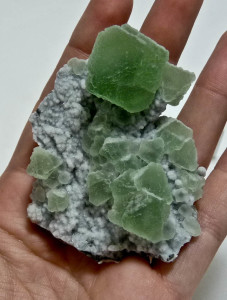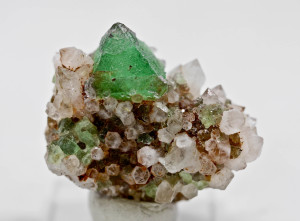Fluorite is one of the most popular minerals for collectors because it is very colorful, abundant, is found in large crystals, and is inexpensive. Thousands of localities worldwide produce specimens of fluorite. There are likely millions of fluorite specimens on the market at any time, never any shortage!
 There are many specialist collectors that collect solely fluorite. It is found in so many habits, colors, and environments that it is hard to get tired of the mineral. Even people who have been focusing on fluorite for years often discover new interesting properties or occurrences of the mineral. There have even been cases of fluorite mineralizing fossils! It is one of the most varied minerals and is enjoyable to look at in both micromount size to large cabinet. For those interested in crystallography, fluorite can show some of the most forms on one crystal out of any minerals.
There are many specialist collectors that collect solely fluorite. It is found in so many habits, colors, and environments that it is hard to get tired of the mineral. Even people who have been focusing on fluorite for years often discover new interesting properties or occurrences of the mineral. There have even been cases of fluorite mineralizing fossils! It is one of the most varied minerals and is enjoyable to look at in both micromount size to large cabinet. For those interested in crystallography, fluorite can show some of the most forms on one crystal out of any minerals.
Fluorite is a mineral that is easily field collected at many sites. Be sure to check tailings piles at abandoned mines for signs of the cubic mineral. Many of the abandoned mines in the Southwestern United States produce very fine specimens of the mineral with little to moderate work. Check any locality you have permission to access with freshly exposed quartz veins for hydrothermal minerals such as fluorite. Large specimens of massive fluorite also look great for landscaping or decorative purposes. Fluorite is non-toxic and weather resistant though some samples may fade in the sunlight so be careful as to what specimens you choose to landscape or decorate with.
 There are several guidelines to picking a good fluorite specimen- make sure the fluorite shows very well developed crystallization. Massive fluorite specimens are generally undesirable for higher end collections of minerals unless they exhibit unusual color or properties such as fluorescence. Make sure the specimens are not seriously damaged or scratched. Fluorite is extremely soft, so slight chipping is acceptable in specimens that have been extracted from hard rocks such as schist, gneiss, or granite though this kind of damage still detracts from the overall value of the piece. Make sure the dealer you are buying specimens from is very up front about any damage occurring to the fluorite when asked. Also, be sure to check if the specimens have been treated with oil, which can hide scratches and chips. Oil treating of fluorite is not a widely accepted process in fluorite. Smell the specimen and see if it has a slight gasoline odor or immerse it in water and see if an oil slick on the surface occurs. Be sure to keep varieties of fluorite that are light sensitive in a dark place. Do not keep them in display cabinets where they receive constant light exposure.
There are several guidelines to picking a good fluorite specimen- make sure the fluorite shows very well developed crystallization. Massive fluorite specimens are generally undesirable for higher end collections of minerals unless they exhibit unusual color or properties such as fluorescence. Make sure the specimens are not seriously damaged or scratched. Fluorite is extremely soft, so slight chipping is acceptable in specimens that have been extracted from hard rocks such as schist, gneiss, or granite though this kind of damage still detracts from the overall value of the piece. Make sure the dealer you are buying specimens from is very up front about any damage occurring to the fluorite when asked. Also, be sure to check if the specimens have been treated with oil, which can hide scratches and chips. Oil treating of fluorite is not a widely accepted process in fluorite. Smell the specimen and see if it has a slight gasoline odor or immerse it in water and see if an oil slick on the surface occurs. Be sure to keep varieties of fluorite that are light sensitive in a dark place. Do not keep them in display cabinets where they receive constant light exposure.
